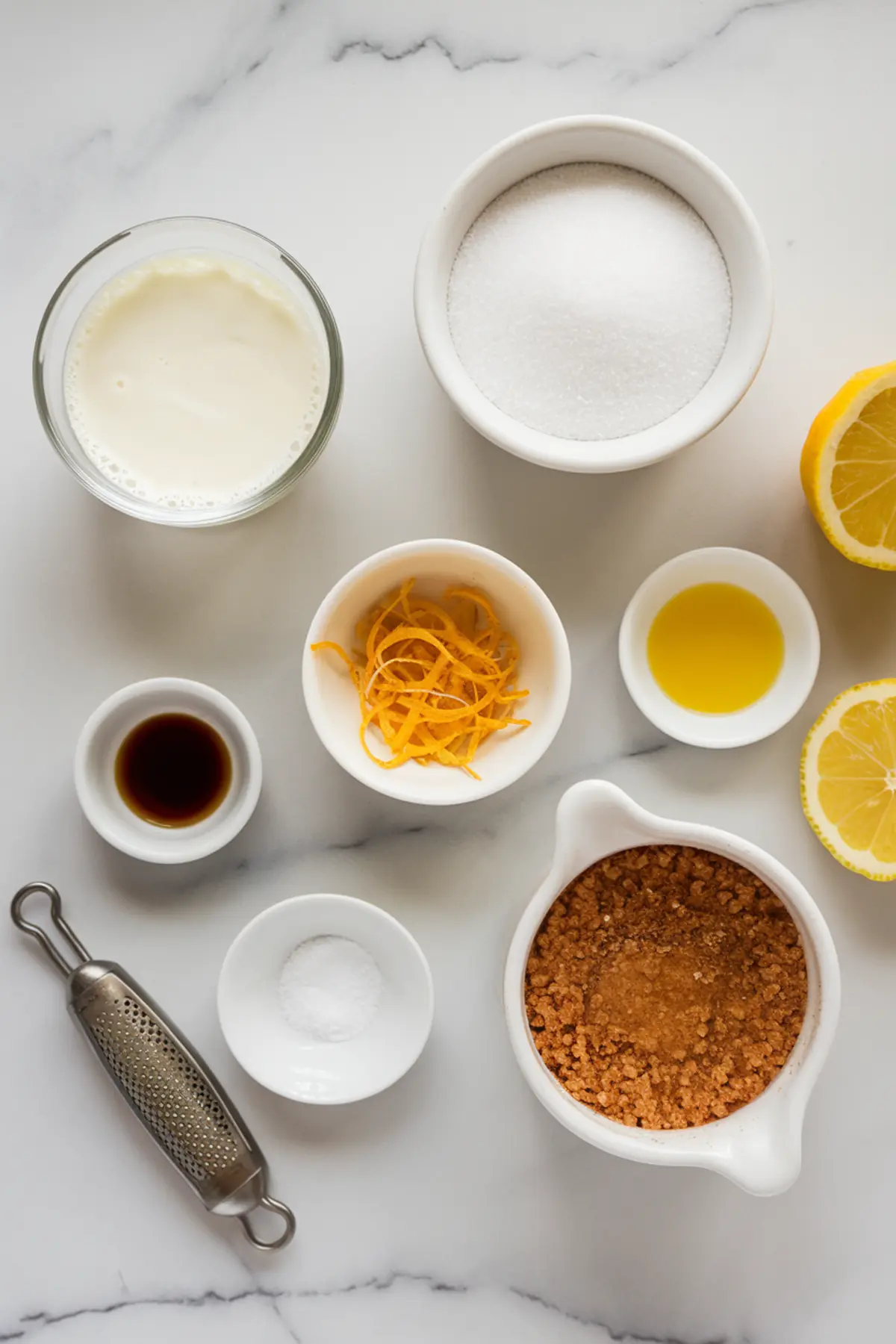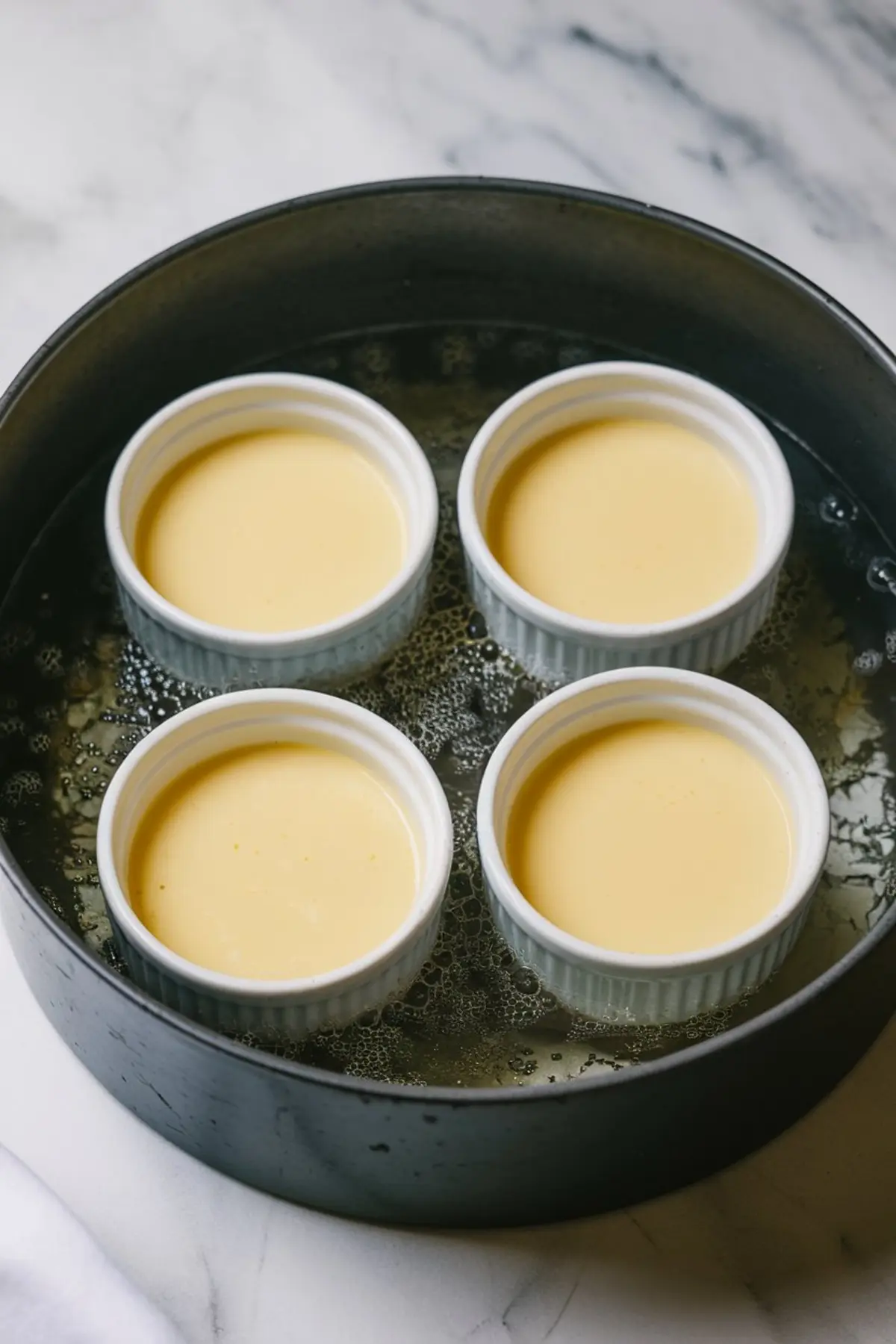Custard desserts trace back through European culinary traditions. Some historians point to similar dishes in medieval times, which shows how people valued creamy sweets long before modern kitchens. I find that lemon flavor adds a refreshing quality that keeps me excited every time I whip up this dish.
Early in my cooking journey, I admired the gentle flavor of crème brûlée. That initial encounter sparked a fascination with the balance between sugar and cream. My love for bright tastes then led me to experiment with lemon, which quickly became my chosen twist.
The result was a custard that teases the tongue with a hint of zest. I discovered that lemon brightens the buttery notes so the custard never tastes heavy. That discovery changed how I view citrus in desserts, and I now seek ways to sprinkle lemon into many recipes.

Key Ingredients and Their Role in Lemon Creme Brulee
Egg yolks bring structure and silkiness to the final custard. They thicken under gentle heat and create that signature spoonable texture. My approach always involves whisking them carefully to avoid any clumps.

Heavy cream contributes richness and a full-bodied mouthfeel. It softens the tangy edge of the lemon, keeping flavors balanced. I prefer heavy cream over lighter substitutes because it promotes a more satisfying custard experience.
Fresh lemon juice and zest inject the vibrant tang that keeps each spoonful interesting. That extra zip draws attention to the caramelized layer on top. I always zest the lemon first, then squeeze out the juice to ensure I use the entire fruit efficiently.

Sugar sweetens the custard and forms the crunchy topping. The crisp top stands in contrast to the soft interior, which appeals to anyone craving texture variety. I sprinkle a thin layer right before torching, or place it under the broiler if a torch isn’t available.
Vanilla extract rounds out the flavor profile and ties everything together. The subtle aroma mingles with the citrus, delivering a gentle fusion of sweet and tart. Salt also plays a small yet mighty role, brightening flavors without overpowering the dish.
Preparing Your Lemon Crème Brûlée with Confidence
My process begins by preheating the oven and arranging the ramekins in a baking dish. I then warm the cream, let it mingle with lemon zest, and allow the infusion to develop. That crucial step lays the groundwork for a balanced flavor once the custard comes together.
Egg yolks get whisked with sugar, salt, and vanilla in a separate bowl. I pour the warm lemon-infused cream slowly into this mixture. Gradual blending helps prevent any unintended curdling that might spoil the texture.
Straining the combined liquid captures bits of egg or stray zest that might interfere with smoothness. I learned that detail early on, and it has made all the difference in achieving a restaurant-quality finish. The final step is distributing the custard into the ramekins, then setting up a gentle water bath.
I pour warm water around the ramekins, taking care that no water splashes into the custard. That moisture bath reduces harsh heat, so the custards bake evenly. I check for a slight jiggle in the center before removing them from the oven.
Insights from My Own Baking Trials

I remember my early missteps with temperature. Overheated cream scalded too quickly, and I scrambled some egg yolks on my first attempt. That minor disaster led me to watch my stove more carefully and keep the heat moderate.
I also learned that lemon flavor intensifies if given time. Resting the custards in the fridge for at least two hours makes each spoonful more vivid. The sugar topping then crackles dramatically when I torch it just before serving, which adds a fun flair to the entire experience.
Friends who taste my Lemon Crème Brûlée often ask for more citrus-based desserts. Some gravitate toward my Lemon Brownies, which have a smooth square shape and an excitingly tart drizzle. Others prefer my Lemon Crumb Bars because of their buttery crumble.
Why Proper Equipment Matters
A reliable kitchen torch guarantees a neat caramel layer. I keep a small butane torch handy and refill it whenever necessary. The precise flame creates that caramel barrier without overbaking the custard underneath.
Heat-resistant ramekins also play a key role. Their individual portions make serving convenient and keep the custard from sloshing during the water bath. They help the dessert hold temperature consistently, which supports a more even bake.
That said, a broiler can substitute if a torch isn’t available. I place the ramekins on a sheet pan to catch any spills and avoid direct contact with the broiler flame. Good observation skills help avoid a burnt top, which can take on a bitter flavor if left unattended.
Detailed Steps for Setting and Baking
The oven temperature typically sits around 325°F (163°C). My experience shows that anything higher can lead to curdling. I watch the baking dish carefully, testing with a gentle shake of the ramekin.
Chilling forms an integral part of the routine. I give the custards enough time in the fridge, letting them rest for a couple of hours or sometimes overnight. That restful period firms the mixture and solidifies the lemon essence.
Torching the sugar is my favorite part. I spread the sugar in a thin layer and watch it bubble into an amber shell. That thin crust stands in contrast to the silky custard, delivering a satisfying crunch that signals each bite.
Garnishing with a Personal Twist
Fresh berries make a bright garnish. I sometimes choose raspberries for their tang or blueberries for their subtle sweetness. A mint sprig adds visual pop, although I often skip it if I want the lemon flavor to remain the star.
My longtime friends argue that adding a few slices of candied lemon elevates the final presentation. I occasionally do that when I serve this dessert for special events. That whimsical topping underscores the lemon theme without overwhelming the custard.
Other Citrus Favorites to Explore
I invite you to try Mini Lemon Tarts if single-serving pastries pique your interest. They feature delicate crusts and creamy lemon centers. I enjoy them on sunny days when a light snack feels delightful.
Lemon Macarons present another adventure with chewy shells and tangy buttercream. Their small size and bright color often impress guests at any gathering. My attempts at macarons taught me patience, but the results always bring smiles.
For lovers of decadent cakes, Lemonade Bundt Cake hits the spot. That bundt shape creates a striking centerpiece. Each slice reveals tender crumbs that carry a subtle citrus zing.
Serving Suggestions and Pairing Ideas

Light whipped cream can complement your Lemon Crème Brûlée. Some folks appreciate the airy feel contrasting with the dense custard. I personally favor a simple dessert plate with no extra toppings, but that’s your choice to make.
Coffee or tea enhances the tasting experience. A hot sip can cleanse the palate between bites and keeps the mood cozy. My close friends regularly brew herbal teas as a companion to lemon-flavored sweets.
Another approach involves fresh fruit on the side. My preference leans toward strawberries, blackberries, or even kiwi slices. That combination of creamy, crunchy, and fresh elements often delights taste buds.
Storing Leftovers Without Losing Quality
I suggest eating Lemon Crème Brûlée soon after torching. The sugar crust stays crisp for a while, but it may soften overnight. Refrigeration protects the custard’s texture, although I prefer to finish each portion the same day.
Covering the ramekins prevents any fridge smells from leaching in. The custard can keep for two days if stored well, but the caramel topping might lose its snap. Reheating is not ideal because that changes the consistency, so I skip attempts to warm it again.
Pin This Recipe and Share Your Thoughts
Friends always praise the balance between the bright lemon essence and the sweet caramelized top. I hope you add this Lemon Crème Brûlée to your personal collection and enjoy every spoonful. Pinners can save it for later on a favorite dessert board to keep the recipe handy.
It helps me learn if you share your outcomes or any creative twists in the comments. I remain open to your tips and experiences, since I believe cooking grows more meaningful with every conversation. Let’s spark a kind and helpful community around this lemon delight.
Lemon Crème Brûlée Recipe

A smooth, creamy custard infused with bright lemon flavor and topped with a crisp caramelized sugar layer. This classic French dessert has a refreshing citrus twist, making it a perfect balance of richness and freshness.
Ingredients
- FOR THE CUSTARD:
- 2 cups heavy cream
- 1/2 cup granulated sugar
- 4 large egg yolks
- 1 teaspoon vanilla extract
- Zest of 1 lemon
- 2 tablespoons fresh lemon juice
- A pinch of salt
- FOR THE CARAMELIZED SUGAR TOPPING:
- 1/4 cup granulated sugar
Instructions
- PREHEAT THE OVEN AND PREPARE THE RAMEKINS: Preheat the oven to 325°F (163°C). Arrange 4-6 ramekins in a deep baking dish, leaving space between each. This setup will allow for a water bath, ensuring even baking.
- HEAT THE CREAM: In a saucepan over medium heat, warm the heavy cream until it starts to steam but does not boil. Stir in the lemon zest and let it steep for 5 minutes to enhance the flavor.
- PREPARE THE EGG MIXTURE: In a mixing bowl, whisk together the egg yolks, sugar, salt, vanilla extract, and lemon juice until the mixture is pale and slightly thickened. Slowly pour the warm cream into the egg mixture while whisking continuously to prevent scrambling.
- STRAIN AND FILL THE RAMEKINS: Strain the custard through a fine-mesh sieve to remove any solids. Evenly divide the mixture among the prepared ramekins.
- CREATE A WATER BATH AND BAKE: Carefully pour hot water into the baking dish until it reaches halfway up the sides of the ramekins. Bake for 30-35 minutes, or until the custard is set but still slightly jiggly in the center. Remove from the oven and let the ramekins cool in the water bath for 10 minutes before transferring them to the refrigerator to chill for at least 2 hours or overnight.
- CARAMELIZE THE SUGAR TOPPING: Before serving, sprinkle about 1 teaspoon of granulated sugar evenly over each custard. Using a kitchen torch, melt the sugar until it forms a golden, crisp caramel crust. If a torch is unavailable, place the ramekins under the oven broiler for 1-2 minutes, watching closely to avoid burning.
- SERVE: Allow the caramelized sugar to set for a minute before serving. Optionally, garnish with fresh berries or a small sprig of mint.
Notes
For the best texture, use heavy cream rather than substitutes like milk or half-and-half. The high fat content ensures a silky, creamy consistency.
When heating the cream, avoid boiling, as high heat can alter the texture and cause curdling. Letting the lemon zest steep for a few minutes enhances the citrus flavor without making the custard too tart.
Tempering the eggs is crucial to prevent scrambling. Slowly adding the warm cream while whisking constantly helps gradually raise the temperature of the eggs, resulting in a smooth custard.
Straining the mixture removes any bits of cooked egg or lemon zest, ensuring a perfectly smooth texture. Skipping this step may result in a slightly grainy consistency.
The water bath (bain-marie) is essential for even baking. The gentle heat prevents the custard from curdling or developing a rubbery texture. Use hot water, but not boiling, to maintain consistent heat throughout the baking process.
The custard is done baking when it is set around the edges but still slightly jiggly in the center. Overbaking can lead to a dense or curdled texture. It will continue to set as it cools.
Chilling for at least 2 hours allows the custard to firm up and develop its full flavor. For best results, refrigerate overnight. Cover the ramekins with plastic wrap to prevent them from absorbing any odors from the fridge.
For the caramelized sugar topping, fine granulated sugar works best, as it melts evenly and creates a crisp, even layer. A kitchen torch provides the best control, allowing you to caramelize the sugar evenly without overheating the custard. If using a broiler, place the ramekins on a baking sheet and monitor closely to prevent burning.
Serve immediately after caramelizing the sugar for the best contrast between the creamy custard and crisp topping. If stored in the refrigerator after caramelizing, the sugar may soften.
Garnishing with fresh berries or a sprig of mint adds a refreshing touch and enhances presentation. If desired, a dusting of powdered sugar can also be added just before serving.
Nutrition Information
Yield
6Serving Size
1Amount Per Serving Calories 433Total Fat 33gSaturated Fat 20gTrans Fat 1gUnsaturated Fat 11gCholesterol 244mgSodium 93mgCarbohydrates 30gFiber 0gSugar 29gProtein 7g

